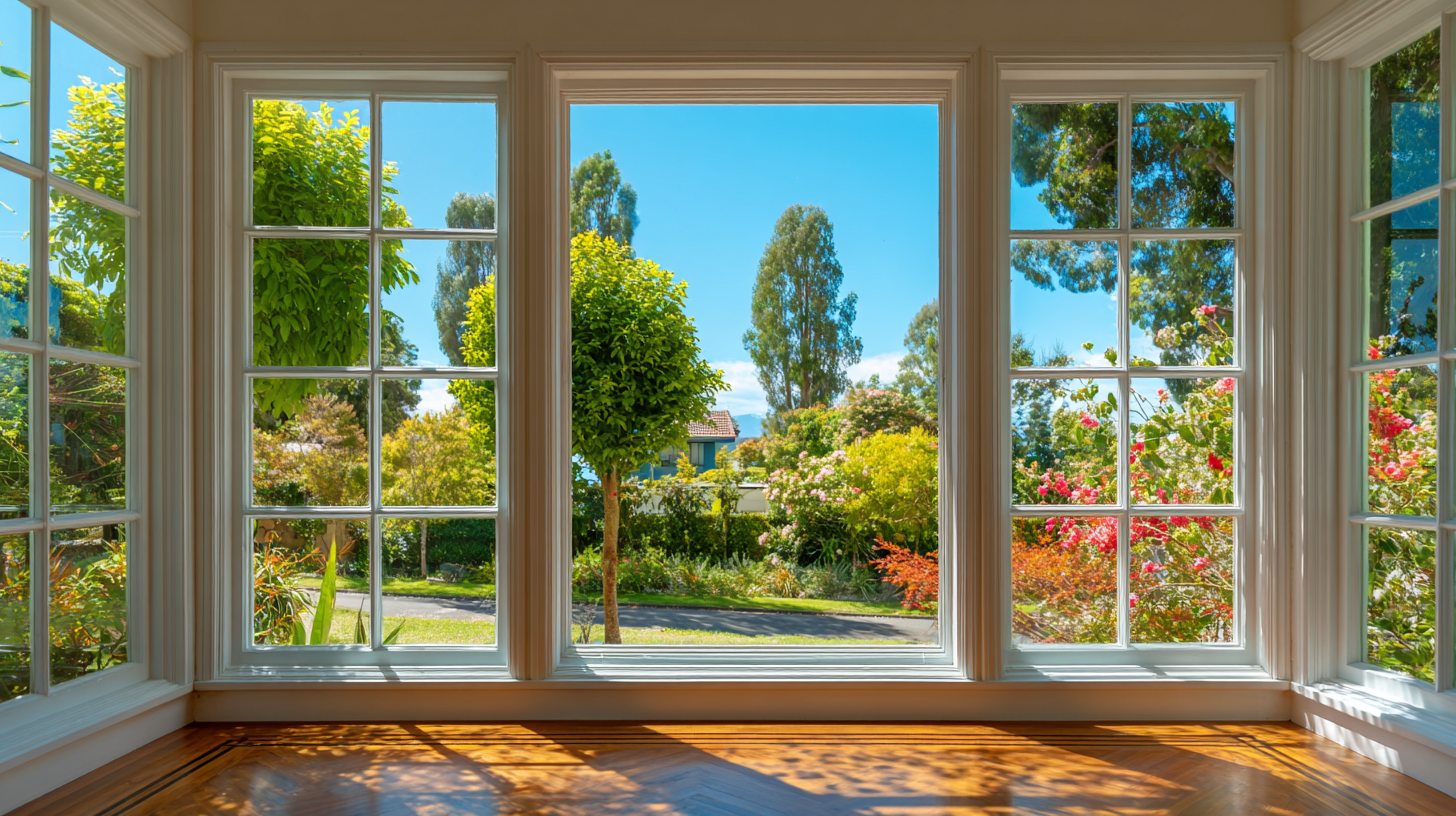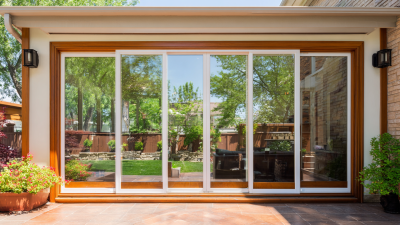The Evolution of Front Windows: How Modern Designs Enhance Energy Efficiency and Style
The evolution of front windows has been a pivotal aspect of modern architectural design, influencing both energy efficiency and aesthetic appeal. Recent studies indicate that advanced window technologies can reduce energy costs by up to 30% in residential buildings, significantly impacting overall energy consumption. For instance, the U.S. Department of Energy reports that windows account for approximately 25-30% of residential heating and cooling energy use, highlighting the critical role of energy-efficient front windows in sustainable construction practices.

The integration of double-glazing, low-emissivity (Low-E) coatings, and innovative frame materials not only enhances the thermal performance of front windows but also contributes to the modern stylistic trends that emphasize natural light and seamless outdoor connections. As architects and builders increasingly prioritize sustainability without compromising design, the transformation in front windows serves as a testament to the changing dynamics of the construction industry, ultimately fostering a more energy-efficient living environment.
Understanding the Historical Development of Front Window Designs
The evolution of front window designs has significantly transformed over the decades, driven by advancements in material science, architectural trends, and increasing awareness of energy efficiency. Historically, front windows were primarily functional, made from simple wooden frames and single-pane glass, often resulting in heat loss and poor insulation. According to the U.S. Department of Energy, traditional windows are responsible for 25% to 30% of residential heating and cooling energy use, highlighting the need for innovation in window design.
As technology advanced, the introduction of double and triple glazing provided improved thermal performance, drastically reducing energy consumption. Modern designs now incorporate Low-E (low emissivity) coatings and argon gas fills, which can cut heat transfer by up to 50% compared to single-pane windows. According to the National Fenestration Rating Council (NFRC), energy-efficient windows can reduce energy costs by 7% to 15% annually. Today, architects are blending style with sustainability, designing expansive, aesthetically pleasing front windows that enhance natural lighting while minimizing energy loss, thus creating welcoming and environmentally friendly homes.
Key Materials Used in Energy-Efficient Front Windows Today
 In the quest for energy efficiency and aesthetic appeal in modern architecture, front windows have undergone significant evolution, primarily through the innovative materials used in their construction. One key material driving this transformation is low-emissivity (Low-E) glass, which is coated with a thin layer of metal oxide that reflects heat while allowing natural light to enter. This technology minimizes energy loss during winter and reduces heat gain in summer, leading to substantial savings on heating and cooling costs.
In the quest for energy efficiency and aesthetic appeal in modern architecture, front windows have undergone significant evolution, primarily through the innovative materials used in their construction. One key material driving this transformation is low-emissivity (Low-E) glass, which is coated with a thin layer of metal oxide that reflects heat while allowing natural light to enter. This technology minimizes energy loss during winter and reduces heat gain in summer, leading to substantial savings on heating and cooling costs.
Additionally, advanced framing materials such as fiberglass and vinyl have become popular due to their superior thermal performance and durability. Unlike traditional wood or aluminum frames, these materials provide excellent insulation and are resistant to the elements, ensuring a longer lifespan with lower maintenance requirements. The combination of these materials has not only improved energy efficiency but also allowed for sleeker, more stylish window designs that complement modern architectural trends. As homeowners increasingly prioritize sustainability, the integration of these innovative materials in front windows marks a significant step forward in building design.
Innovative Technologies that Improve Window Insulation and Aesthetics
The advent of innovative technologies has revolutionized window designs, significantly enhancing both insulation and aesthetics. Modern windows are now equipped with features like triple glazing and low-emissivity (Low-E) coatings, which provide superior thermal performance. Triple glazing, with its layers of glass separated by inert gas fills, forms a highly effective barrier against heat transfer, ensuring indoor environments remain comfortable while reducing energy consumption. Meanwhile, Low-E coatings reflect heat during summer and trap it during winter, further optimizing energy efficiency throughout the year.
In addition to their insulating properties, contemporary windows are designed with aesthetics in mind. Advancements in manufacturing techniques allow for sleek frames made from materials such as fiberglass and composite, which not only improve durability but also contribute to a modern, stylish appearance. Customization options have exploded, offering diverse shapes, colors, and finishes that can enhance the architectural integrity of any building. This blend of functionality and beauty ensures that modern windows not only serve practical purposes but also elevate the overall design of homes and commercial spaces, making them a focal point of contemporary architecture.
Design Trends in Modern Front Windows: Merging Functionality with Style
The design of modern front windows has seen significant transformation, focusing on merging functionality with aesthetic appeal. As homeowners increasingly prioritize energy efficiency, the incorporation of advanced glazing technologies has gained momentum. According to the Department of Energy, windows account for 25-30% of residential heating and cooling energy use. This statistic underscores the importance of choosing windows that not only enhance a home's exterior but also contribute to energy savings.
Current trends in front window designs include larger panes and minimalistic frames, which allow for more natural light and a seamless connection with the outdoors. In fact, studies have shown that homes with expansive windows can reduce artificial lighting needs by up to 40%. Alongside this, energy-efficient features such as low-emissivity (Low-E) coatings and triple-glazing systems have become popular, offering improved insulation and reducing heating costs by approximately 15%.
Tips: When selecting modern front windows, consider models with Energy Star certification to ensure optimal performance. Additionally, opt for styles that complement your home's architecture while maximizing natural light. To enhance the overall aesthetic, choose frame colors that harmonize with your exterior palette, creating a cohesive and inviting look.

Guidelines for Choosing the Right Front Window Design for Your Home
When selecting the right front window design for your home, several key factors should be considered to balance both energy efficiency and aesthetic appeal. First, evaluate the materials used in window construction. Options like fiberglass and vinyl offer superior insulation compared to traditional wood, significantly reducing energy costs while requiring less maintenance. Additionally, look for windows with double or triple glazing, as these multiple panes provide better thermal barriers and limit heat transfer, keeping your home comfortable year-round.
Next, consider the architectural style of your home. The front window design should complement the overall aesthetics while enhancing curb appeal. For modern homes, sleek, large windows can create a seamless integration with the outdoors. In contrast, traditional homes may benefit from divided-light windows that reflect classic characteristics. You might also explore energy-efficient coatings and tints, which can protect against UV rays and help maintain interior temperatures while adding a stylish touch to your home's exterior. By understanding these guidelines, homeowners can make informed decisions that reflect their style while prioritizing energy efficiency.


